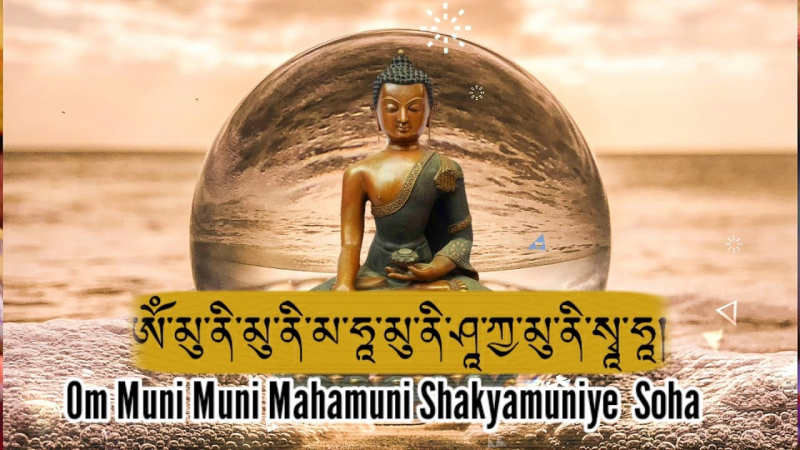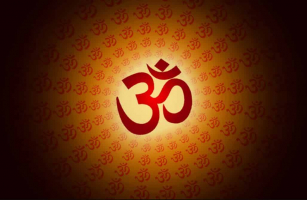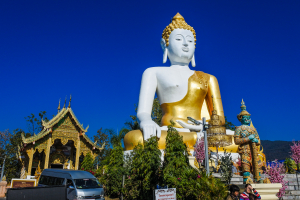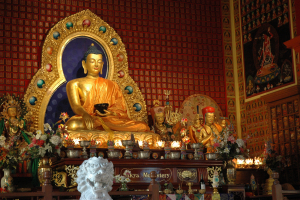Top 15 Most Powerful Buddhist Mantras
You've come to the right site if you want to learn more about the most powerful Buddhist mantras. Most Buddhist mantras, also known as Buddhist meditation ... read more...chants, are based on the Buddha's and bodhisattvas' central teachings. They enable practitioners to connect with the essence of the spiritual system's tradition and pave the way to enlightenment. Here are the most powerful Buddhist mantras practiced worldwide, along with their meanings.
-
Sanskrit: Om Mani Padme Hum
English: I now invoke the Universal sound, the jewel, the goal of Enlightenment, love, and compassion, Lotus wisdom, and a pure indivisible unity of wisdom with practice.
"Om Mani Padme Hum" is the widely recognized mantra in Tibetan Buddhism associated with Avalokiteshvara, the Bodhisattva of Compassion. Each syllable in this powerful mantra holds its own significance, representing the exalted body, speech, and mind of enlightened beings ('Om'), the precious jewel-like intention to attain enlightenment ('Mani'), wisdom and purity like a lotus ('Padme'), and the inseparability of enlightenment and compassion ('Hum'). By reciting this mantra, practitioners aim to cultivate compassion and wisdom within themselves and connect with Avalokiteshvara's enlightened mind.
Chanting this mantra fosters compassion and loving-kindness towards all beings, promoting a sense of interconnectedness and empathy. It is believed to purify negative karma, accumulate positive merit, and facilitate progress on the path to enlightenment. Through meditative practice, the mantra aids in achieving mindfulness, inner peace, and mental clarity. Its protective vibrations create positive energy, bestowing blessings upon the environment and those around the practitioner, promoting healing and tranquility.
By chanting this sacred mantra, practitioners establish a profound link with Avalokiteshvara, seeking the Bodhisattva's compassionate guidance and blessings on their spiritual journey. Remember, sincerity and devotion enhance the potency of the mantra's benefits. Whether you are a Buddhist practitioner or not, embrace the positive messages and intentions of 'Om Mani Padme Hum' to facilitate personal growth, compassion, and inner peace. Experience the profound effects of this mantra as a powerful tool for well-being and spiritual awakening.
The mantra of Avalokiteshvara, OM MANI PADME HUM, in Tibetan script on the petals of a lotus with the seed syllable HRI in the center. - Photo on Wikimedia Commons (https://commons.wikimedia.org/wiki/File:OM_MANI_PADME_HUM.svg) Video by MANIX -
Sanskrit: Namo Bhagavate Śūraṅgama Dhāraṇī Sūtra
The Shurangama mantra is revered as one of the most powerful Buddhist mantras. Originating from the Shurangama Sutra, a significant Mahayana Buddhist scripture, this mantra carries profound spiritual significance and offers various benefits to practitioners.
The mantra, "Namo Bhagavate Śūraṅgama Dhāraṇī Sūtra" pays homage to the compassionate qualities of the Buddha and is known for its protective and purifying abilities. Chanting the Shurangama mantra is believed to provide protection from obstacles, cleanse negative karma, and empower spiritual growth. Regular practice cultivates inner peace, wisdom, and the path to liberation and enlightenment.
As a potent tool in Buddhist traditions, reciting the Shurangama mantra with sincerity and devotion can lead to transformative experiences, guiding practitioners closer to the ultimate goal of Buddhism - liberation from suffering and the realization of enlightenment.

Shurangama Mantra - Photo on Wikimedia Commons (https://commons.wikimedia.org/wiki/File:Shurangama_Mantra_梵文大佛頂首楞嚴咒.開寶四年刻.971年.jpg) Video by Meditation Melody -
Sanskrit: Namaḥ Saptanaṁ Samyaksaṁbuddha Koṭinaṁ Tad-yathā Oṁ Cale Cule Cundi Svāhā
The Cundi Bodhisattva mantra is a sacred chant in Mahayana Buddhism dedicated to Bodhisattva Cundi (also known as Zhunti or Chundi). Cundi Bodhisattva is revered as the embodiment of wisdom, compassion, and boundless virtues. The mantra is believed to hold profound meanings and offer various spiritual benefits to its practitioners.
Meaning and Significance of the Cundi Bodhisattva mantra:
- "Namaḥ": Expresses reverence and devotion, paying homage to Cundi Bodhisattva and the enlightened ones.
- "Saptanaṁ Samyaksaṁbuddha Koṭinaṁ": Honoring the countless Buddhas of the past, present, and future who have attained supreme enlightenment.
- "Tad-yathā": Aspiration for the mantra to be just like the Buddhas, carrying their wisdom and compassion.
- "Oṁ Cale Cule Cundi Svāhā": The main mantra invoking Cundi Bodhisattva's blessings and protection.
Chanting this mantra invokes the wisdom and compassion of Cundi Bodhisattva, aiding practitioners in developing these qualities in their own lives. The mantra's recitation purifies negative karma and obstacles, leading to spiritual purification and progress on the path to liberation. Regular practice of the mantra can bring inner peace, clarity, and a sense of calmness, promoting mental well-being.
Chanting the mantra invites Cundi Bodhisattva's protection and blessings, safeguarding practitioners from negative influences and harmful energies. The mantra supports spiritual growth and transformation, guiding practitioners toward greater insight and understanding. By invoking Cundi Bodhisattva's compassionate energy, the mantra helps beings overcome suffering and achieve liberation.
Photo on Wikimedia Commons (https://commons.wikimedia.org/wiki/File:Cundi_Bodhisattva,_flanked_by_devas.jpg) Buddhalands -
Sanskrit: Nam Myoho Renge Kyo
English: Devotion to the Lotus Sutra of the Magnificent Law.
This is an important mantra in the Nichiren school of Buddhism. Nichiren Daishonin, a renowned 13th century Japanese monk, regarded the title as the fundamental essence of the Lotus Sutra. The mantra was ingeniously crafted by incorporating the term "nam" as a prefix to the revered title of the Lotus Sutra, known as "Myoho Renge Kyo." The mantra, also referred to as the daimoku, holds the profound significance of "Devotion to the Lotus Sutra of the Magnificent Law."
Followers of Nichiren Buddhism, including those affiliated with Nichiren Shoshu, Nichiren Shu, or Soka Gakkai International, engage in the practice of chanting the daimoku in the presence of the Gohonzon, which serves as their revered object of worship.
By diligently reciting this mantra, individuals can attain a state of unity with the enlightened mind of the Buddha. This profound connection empowers them to unlock and manifest the inherent virtues of Buddhahood, including wisdom, compassion, courage, and perseverance. When one's life condition has been elevated to the state of Buddhahood, they can overcome all challenges and achieve the ultimate victory in life.

Photo on LotusBuddhas (https://lotusbuddhas.com/the-meaning-of-nam-myoho-renge-kyo.html) Video by Meditative Mind -
Sanskrit: Gate Gate Pāragate Pārasaṃgate Bodhi Svāhā
English: Going, going, going on beyond, always going on beyond, always becoming Buddha.
The mantra "Gate Gate Pāragate Pārasaṃgate Bodhi Svāhā" is a powerful and well-known phrase from the Heart Sutra, one of the most revered texts in Mahayana Buddhism. This mantra holds profound meanings and is believed to offer various benefits to its practitioners.
Meaning of the mantra: the mantra represents the stages of realization and liberation from suffering, leading to enlightenment and the ultimate truth of existence.
- "Gate": Translates to "gone" or "gone beyond," signifying the realization of emptiness, the true nature of all things.
- "Pāragate": Means "gone to the other shore" or "gone beyond the other shore," symbolizing the transcendence of suffering and ignorance.
- "Pārasaṃgate": Translates to "gone completely beyond," representing the complete liberation from all delusions and attachments.
- "Bodhi": Refers to enlightenment, the state of awakening and understanding the true nature of reality.
- "Svāhā": A concluding word often used in Buddhist mantras, expressing dedication and offering.
Benefits of chanting the Heart Sutra mantra:
- Wisdom and Understanding: Reciting the mantra is believed to deepen one's wisdom and understanding of the true nature of reality, leading to insights into the nature of suffering and its cessation.
- Liberation from Delusions: Chanting the mantra can help practitioners liberate themselves from delusions, attachments, and ignorance, freeing them from suffering and cyclic existence.
- Inner Peace and Calm: The repetition of the mantra can serve as a meditative practice, promoting inner peace, focus, and mindfulness.
- Spiritual Progress: By invoking the essence of the Heart Sutra, practitioners advance on the path to spiritual growth and enlightenment.
- Protection and Guidance: The mantra is considered a source of spiritual protection and guidance, helping practitioners navigate life's challenges with clarity and resilience.
- Transcendence and Liberation: Chanting the mantra symbolizes the journey of transcending limitations and attaining ultimate liberation, culminating in the state of enlightenment.

Photo on Wikimedia Commons (https://commons.wikimedia.org/wiki/File:Heart_Sutra_Chinese_calligraphy_sheet_20160913.jpg) Video by Plum Village App -
Sanskrit: Om Tare Tuttare Ture Soha
English: I invoke the Universal sound and the Green Tara to bring deliverance from suffering and delusion, paving the way for compassion and Enlightenment. I offer this prayer to Green Tara.
"Om Tare Tuttare Ture Soha" is dedicated to Green Tara, a compassionate and swift-acting female Bodhisattva in Tibetan Buddhism. Each syllable of the mantra holds significance, with 'Om' representing universal essence and 'Tare' invoking Tara's liberating energy. 'Tuttare' offers protection from dangers, while 'Ture' symbolizes overcoming fears. By chanting this mantra, practitioners can experience compassion, protection, and the removal of obstacles hindering spiritual progress.
Chanting this powerful mantra brings swift assistance and blessings, helping to overcome challenges and fears. It nurtures emotional healing and well-being while guiding practitioners toward their aspirations and goals. Regular recitation fosters a deeper connection with Green Tara's enlightened qualities, facilitating spiritual growth and awakening.
Approach the recitation with sincerity and devotion, understanding its profound significance. Regardless of religious background, the mantra's positive intentions and symbolism can be appreciated for personal growth, protection, and spiritual development. Invoke Green Tara's compassion and swift action through the Green Tara Mantra on your journey to inner peace and enlightenment.

The Green Tara Mantra - Photo on Mandalas Life (https://mandalas.life/2018/the-green-tara-mantra-banner/) Video by Meditative Mind -
The Great Compassion mantra, also known as the "Da Bei Zhou" or "Dharani of Great Compassion," originates from the Mahayana Buddhist scripture called the "Great Compassion Dharani Sutra." This powerful mantra is revered for its profound meaning and numerous benefits.
Meaning of the Great Compassion mantra: The mantra is dedicated to Avalokiteshvara, the Bodhisattva of Great Compassion, and invokes the qualities of enlightenment and compassion of all Buddhas and Bodhisattvas.
The Great Compassion mantra is a Sanskrit dharani that is often chanted as "Namo Ratna Trayaya, Namo Arya Jnana Sagara, Vairochana, Byuhara Jara Tathagataya, Arahate, Samyaksam Buddhaya, Namo Sarwa Tathagate Bhyay, Arhata Bhyah, Samyaksam Buddhe Bhyah, Namo Arya Avalokite shoraya Bodhisattvaya, Maha Sattvaya, Maha Karunikaya, Tadyata, Om Dara Dara, Diri Diri, Duru Duru Itte We, Itte Chale Chale, Purachale Purachale, Kusume Kusuma Wa Re, Ili Milli, Chiti Jvalam, Apanaye Shoha.
Benefits of the Great Compassion mantra:
- Cultivating Compassion: Chanting this mantra fosters a deep sense of compassion and loving-kindness towards all beings, promoting empathy and interconnectedness.
- Purification and Blessings: The mantra purifies negative karma and brings blessings from enlightened beings, leading to positive transformations in one's life.
- Protection from Harm: Practicing the Great Compassion mantra offers protection from physical and spiritual dangers, dispelling negative energies and malevolent forces.
- Overcoming Obstacles: The mantra helps practitioners overcome various obstacles, challenges, and difficulties on their spiritual path.
- Healing and Peace: Chanting this mantra is believed to have healing effects on the body and mind, promoting inner peace and well-being.
- Liberation from Suffering: By invoking the Bodhisattva's compassionate energy, the mantra guides beings towards liberation from suffering and cyclic existence.
Regular recitation of the Great Compassion mantra is considered a profound and transformative practice, bringing practitioners closer to the enlightened qualities of Avalokiteshvara and, ultimately, the path of enlightenment.

Photo on Wildmind Video by Ani Choying Drolma [ Official ] -
Sanskrit: Om Ah Hum Vajra Guru Padma Siddhi Hum - Om Ah Hum Benza Guru Pema Siddhi Hum
The Vajra Guru mantra is a sacred and powerful chant in Tibetan Buddhism, dedicated to Guru Padmasambhava, also known as Guru Rinpoche. Guru Padmasambhava is a revered figure who played a crucial role in establishing Buddhism in Tibet. The mantra is believed to hold profound meanings and offer various benefits to its practitioners.
Meaning of the Vajra Guru mantra: the mantra signifies the invocation of Guru Padmasambhava's wisdom, compassion, and enlightened presence to guide and bless practitioners on their spiritual path.
- "Om": Represents the universal sound and the essence of enlightened body, speech, and mind.
- "Ah": Symbolizes the wisdom of Guru Padmasambhava, which is beyond ordinary understanding.
- "Hum": Represents the indivisible nature of wisdom and compassion.
- "Vajra Guru": Refers to Guru Padmasambhava, whose name translates to "Vajra Guru," symbolizing his unshakable and enlightened nature.
- "Padma": Refers to the lotus, symbolizing purity and spiritual realization.
- "Siddhi": Represents spiritual attainment or accomplishment.
In Tibetan Buddhism, chanting "Om Ah Hum Vajra Guru Padma Siddhi Hum" has many benefits. The mantra invokes Guru Padmasambhava's wisdom and compassion to bless and guide practitioners. Reciting it purifies negative karma, turning afflictions into virtues and bringing inner serenity. The mantra shields against barriers and harmful effects. This ancient chant connects practitioners to Guru Padmasambhava and his lineage, helping them progress spiritually. Enlightenment and Guru Padmasambhava's guidance are available to anyone who chant the Vajra Guru mantra regularly.

Photo on Wallpaper Flare (https://www.wallpaperflare.com/search?wallpaper=vajra) Melodious Dharma Sound -
Sanskrit: Om A Ra Pa Ca Na Dhih
The mantra associated with Manjushri, a revered bodhisattva of wisdom, is widely recognized. The deity is commonly portrayed holding a sword in his right hand, representing his adeptness in dispelling illusions. Additionally, he grasps the stem of a lotus flower in his left hand, which supports a book.
Meaning of the mantra: the mantra signifies the dedication to Manjushri and the aspiration to attain wisdom, clarity, and insight into the true nature of reality.
- "Om": Represents the universal sound and the essence of enlightened body, speech, and mind.
- "A Ra Pa Ca Na": These syllables are known as the "five syllables of Manjushri" and represent the purified aspects of the five aggregates, which are the components of individual existence.
- "Dhih": This syllable embodies the power of Manjushri's wisdom and intellect.
By chanting this powerful mantra, individuals are able to unlock and harness an abundance of wisdom from within themselves, ultimately leading to enhanced clarity and understanding in all aspects of life. The product assists individuals in making informed choices in their everyday activities.
The mantra is thought to dispel ignorance and delusion, guiding practitioners away from confusion and towards clarity. Students and scholars often chant this mantra to enhance their learning abilities, improve memory, and gain a deeper understanding in their studies. By invoking Manjushri's wisdom, practitioners seek help overcoming obstacles and challenges on their spiritual journey. The mantra is considered protective, providing spiritual guidance and support on the path of wisdom and enlightenment.

Photo on Collections - GetArchive (https://jenikirbyhistory.getarchive.net/amp/media/center-figure-detail-acala-the-buddhist-protector-cropped-2f2e84) Video by Next Level Meditation -
Sanskrit: Om Muni Muni Mahamuni Shakyamuniye Svaha
English: I invoke the Universal sound, Buddha nature, and the wise one, wise one of the Shakyans, hail to thee!
The Shakyamuni Mantra "Om Muni Muni Mahamuni Shakyamuniye Svaha." This revered Buddhist chant pays homage to Siddhartha Gautama, the historical Buddha, known as Shakyamuni. Each component of the mantra holds deep significance, starting with the sacred syllable 'Om,' representing the universal essence and the enlightened body, speech, and mind of the Buddha. Through the repetition of 'Muni' and 'Mahamuni,' the mantra symbolizes the Buddha's profound wisdom and greatness. 'Shakyamuniye' directly refers to Siddhartha, born into the Shakya clan. The mantra concludes with 'Svaha,' expressing dedication and offering. By reciting this mantra, practitioners connect with the enlightened wisdom and compassion of Shakyamuni Buddha, purify negativity, and progress on their spiritual journey.The Shakyamuni Mantra embraces many spiritual benefits. Chanting this sacred mantra fosters a deep connection with Shakyamuni Buddha, enhancing understanding of his teachings and qualities. With each recitation, negative emotions and thoughts are believed to be purified, promoting inner peace and clarity. The mantra serves as a powerful tool for personal growth, cultivating wisdom and insight into the true nature of reality. Its repetition brings blessings and protection, enveloping the environment in positive energy and promoting overall well-being.
The Shakyamuni Mantra is an act of sincere devotion and gratitude to the Buddha, expressing reverence for his teachings and guidance. The mantra becomes a gateway to spiritual progress through dedicated practice, fostering self-awareness and enlightenment. Embrace the transformative power of the Shakyamuni Mantra, and embark on a journey of wisdom, compassion, and profound spiritual growth.

Photo from YouTube Melodious Dharma Sound Video by mefiz -
Sanskrit: Om Dzambhala Dzalim Dzaye Svaha
The Yellow Dzambhala mantra is a sacred chant in Tibetan Buddhism dedicated to Yellow Dzambhala, also known as Jambhala or Dzambala. He is a deity associated with wealth, abundance, and prosperity. Chanting this mantra is believed to bring blessings for attracting wealth, good fortune, and luck.
Meaning of the Yellow Dzambhala mantra:
- "Om": Represents the universal sound and the essence of enlightened body, speech, and mind.
- "Dzambhala": Refers to the deity Yellow Dzambhala, who embodies the qualities of wealth and prosperity.
- "Dzalim": Represents the giving nature of Dzambhala, signifying his ability to provide abundance and generosity.
- "Dzaye": Represents the compassionate nature of Dzambhala, who bestows blessings and good fortune.
- "Svaha": A concluding word often used in Buddhist mantras, expressing dedication and offering.
Chanting the Yellow Dzambhala mantra offers benefits related to wealth and luck. By reciting this sacred mantra, practitioners harness positive energy to attract material abundance, prosperity, and financial well-being into their lives. The blessings of Yellow Dzambhala empower individuals to overcome financial obstacles and challenges, assisting in times of need. Moreover, the mantra fosters a spirit of generosity, promoting positive karma and a giving attitude toward others. Its association with luck and good fortune brings opportunities and positive outcomes in various aspects of life. Additionally, the mantra is believed to offer protection from poverty and financial hardships, imparting a sense of security and stability. Amidst the pursuit of external wealth, the practice of the Yellow Dzambhala mantra cultivates inner peace, contentment, and gratitude, nurturing a balanced and fulfilled life.

Photo on LotusBuddhas (https://lotusbuddhas.com/yellow-dzambhala-mantra-for-wealth-luck.html) Video by Buddhist Music -
Sanskrit: Oṃ Maṇipadme Hūṃ Phaṭ
The White Umbrella Goddess, also known as Sitatapatra or Dukkar, is a revered deity in Tibetan Buddhism. She is depicted holding a white umbrella, which symbolizes her protective and shielding qualities. The White Umbrella Goddess mantra is chanted to invoke her blessings and protection, offering various spiritual benefits to its practitioners.
Meaning and Significance of the White Umbrella Goddess mantra:
- "Om": Represents the universal sound and the essence of enlightened body, speech, and mind.
- "Maṇipadme": The mantra is a variation of the well-known mantra "Om Mani Padme Hum," symbolizing the jewel in the lotus. It signifies the union of wisdom and compassion.
- "Hūṃ": This syllable is a seed mantra, signifying protection and purifying negativity.
- "Phaṭ": Represents the dispelling of obstacles and negative influences.
Chanting the mantra is widely believed to provide individuals with protection against both physical and spiritual threats, effectively safeguarding them from harm and warding off negative energies. The recitation of the mantra is believed to have the ability to purify negative karma and defilements, thereby creating a clear path for individuals to make spiritual progress and experience inner transformation.
By invoking the blessings of the White Umbrella Goddess, practitioners can overcome spiritual obstacles and hindrances on their journey toward enlightenment. The mantra serves as a powerful tool in this regard.
Chanting the mantra is believed to possess healing properties, fostering physical and mental well-being. The vibrations of the mantra have a calming effect on the mind and help to pacify aggressive emotions, promoting a sense of inner peace and clarity.
The White Umbrella Goddess mantra is a powerful tool that offers comprehensive protection to individuals, shielding them from various forms of harm. This sacred mantra is a safeguard, providing internal and external security to those who practice it diligently.
Regular and sincere practice of the White Umbrella Goddess mantra enables devotees to unlock many spiritual benefits, including protection, purification, and inner growth. This dedicated practice fosters a deep sense of safety and empowerment, guiding individuals on their transformative spiritual journey.
Photo on LotusBuddhas (https://lotusbuddhas.com/white-umbrella-goddess-mantra.html) Video by Bernagchen Rangjung Gyalmo -
Sanskrit: Tayata Om Bekanze Bekanze Maha Bekanze Radza Samudgate Soha
English: I now invoke the Universal sound to release the pain of illness, release the pain and darkness of delusion, and to achieve supreme spiritual heights. I offer this prayer to the Medicine Buddha.
"Tayata Om Bekanze Bekanze Maha Bekanze Radza Samudgate Soha." This sacred mantra is associated with the Medicine Buddha, renowned for its healing qualities in Tibetan Buddhism. Each element of the mantra holds significance, with 'Om' representing universal essence and 'Bekanze' emphasizing healing aspects. 'Radza Samudgate' highlights the Medicine Buddha as the King of Medicine, capable of alleviating suffering. Through dedicated recitation, practitioners can experience healing, purification, spiritual growth, and protection from various forms of suffering.Chanting this mantra, individuals can promote physical and mental well-being, alleviate illnesses, and transform negative karma into positive qualities. The Medicine Buddha's blessings cultivate compassion, empower practitioners, and offer protection from afflictions. Regular recitation generates positive energy, harmonizing the practitioner and their surroundings, fostering balance and inner peace.
The Medicine Buddha Mantra is a potent tool for those seeking healing, spiritual growth, and enlightenment. With sincere intention and devotion, practitioners can experience the transformative effects of this sacred mantra, deepening their connection with the compassionate and healing aspects of the Medicine Buddha. Embrace the journey of well-being and enlightenment with the Medicine Buddha Mantra as a guiding force.

Photo from YouTube Buddhist Music West Point -
Sanskrit: Oṃ Ha Ha Ha Vismaye Svāhā – Om Ha Ha Ha Win Sam Mo Ti So Ha
The Ksitigarbha Bodhisattva mantra is a sacred mantra in Buddhism dedicated to Ksitigarbha Bodhisattva, also known as Jizo Bosatsu in Japanese Buddhism. Ksitigarbha is revered as a compassionate Bodhisattva who vows to alleviate suffering and guide beings in the realms of existence.
Meaning of the Ksitigarbha Bodhisattva mantra: The Ksitigarbha Bodhisattva mantra is chanted as "Oṃ Ha Ha Ha Vismaye Svāhā" or "Om Ha Ha Ha Win Sam Mo Ti So Ha." Each syllable holds its own significance:
- "Oṃ" or "Om": Represents the universal sound and the essence of enlightened body, speech, and mind.
- "Ha Ha Ha": The repeated "Ha" syllables are believed to represent the laughter of the Bodhisattva, signifying boundless joy and compassion.
- "Vismaye Svāhā" or "Win Sam Mo Ti So Ha": A concluding word often used in Buddhist mantras, expressing dedication and offering.
Benefits of chanting the Ksitigarbha Bodhisattva mantra:
- Compassion and Alleviation of Suffering: Chanting this mantra invokes the compassionate energy of Ksitigarbha Bodhisattva, seeking guidance and support to alleviate suffering in various realms of existence.
- Inner Peace and Joy: The repeated "Ha Ha Ha" syllables are thought to evoke boundless joy and positive energy, promoting inner peace and well-being.
- Protection and Guidance: Practitioners believe that the mantra brings protection from negative influences and offers guidance on the path of virtue and compassion.
- Purification and Transformation: The mantra's recitation is believed to purify negative karma and transform afflictions, fostering spiritual growth and understanding.
- Intercession for Beings in the Afterlife: Ksitigarbha Bodhisattva is often associated with guiding beings in the realms of existence, especially those in the afterlife. Chanting the mantra is thought to invoke the Bodhisattva's intercession and blessings for departed souls.
It's important to approach the recitation of any sacred mantra with sincerity, devotion, and understanding of its significance. Whether you are a Buddhist practitioner or not, the Ksitigarbha Bodhisattva mantra's positive intentions and symbolism can be appreciated and utilized for personal growth, compassion, and spiritual development.
Buddhist temple art including a central statue of Ksitigarbha Bodhisattva, and his Pure Land including attendant bodhisattvas, and arhats who are paying their respects. Saigon, Vietnam. - Photo on Wikimedia Commons (https://commons.wikimedia.org/wiki/File:Ksitigarbha_Statue_Mural_Vietnam.jpeg) Buddhist Music -
Sanskrit: Om Vajrapani Hum
The Vajrapani Bodhisattva mantra is a powerful and sacred chant in Buddhism, often used to banish evil and negative influences. Vajrapani is a Bodhisattva associated with strength, power, and the ability to protect and subdue malevolent forces. Chanting this mantra is believed to invoke the fierce and wrathful energy of Vajrapani to dispel evil, obstacles, and harmful energies.
Meaning of the Vajrapani Bodhisattva mantra:
- "Om": Represents the universal sound and the essence of enlightened body, speech, and mind.
- "Vajrapani": Refers to the deity Vajrapani, whose name translates to "Vajra in the hand," symbolizing his unshakable and powerful nature.
- "Hum": This syllable is a seed mantra, signifying the power of transformation and protection.
By invoking the fierce and powerful energy of Vajrapani, the practitioner gains protection and a shield against harmful energies, evil spirits, and malevolent forces. The mantra dispels obstacles and difficulties on the spiritual path, instilling courage and inner strength to confront challenges and fears. It pacifies aggressive emotions, promotes inner peace, and calms the mind. With Vajrapani's wrathful energy, the mantra subdues negative influences, fostering personal growth and transformation by overcoming inner obstacles and self-limiting beliefs. Chanting this sacred mantra cultivates a sense of spiritual safety and empowers the practitioner to navigate life with renewed confidence, free from the grasp of malevolence and negativity.

Photo on LotusBuddhas (https://lotusbuddhas.com/vajrapani-bodhisattva-mantra.html) Video by Buddhist Music




































